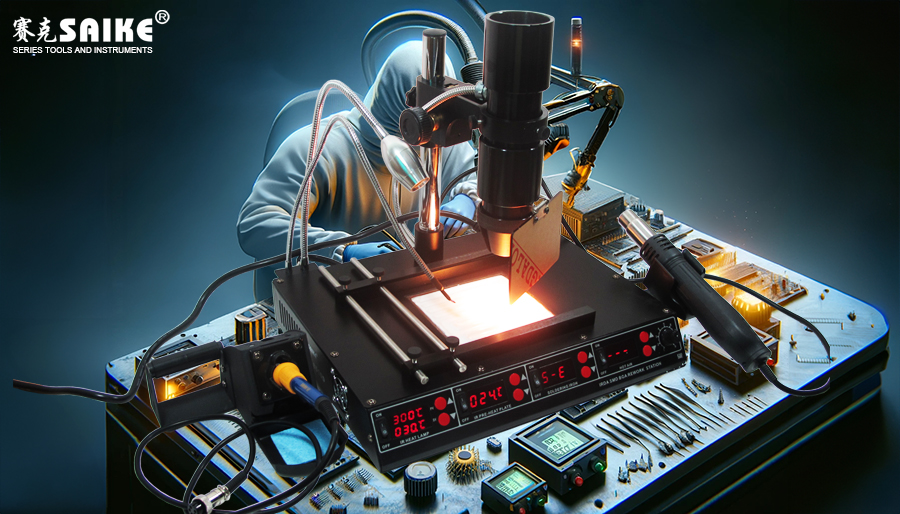
SK-YJ000HWXCHT-KP 100013
The infrared rework station is a precise soldering and desoldering tool suitable for various types of circuit boards. Due to differences in the structure, materials, and components of different circuit boards, adjustments need to be made based on the characteristics of each board when using the infrared rework station. This article will detail how to use an infrared rework station on various circuit boards, ensuring precise, safe, and efficient soldering and desoldering processes.
I. Single-sided and Double-sided Circuit Boards
Characteristics:
– Single-sided boards have components and soldering only on one side, feature a simple design with low density, and are typically used in low-cost electronic devices.
– Double-sided boards can have components and soldering on both sides, have a higher density, and are suitable for moderately complex electronic devices.
Tips:
1.Temperature Settings:
– Single-sided and double-sided boards are generally simpler with lower solder joint density. The preheating temperature should be controlled between 100°C and 120°C, and the soldering or desoldering temperature should be set according to the solder type.
– The upper temperature limit should be below the heat resistance limit of the components to avoid damaging surrounding elements.
2.Even Heating:
– Ensure that the infrared radiation evenly covers the target solder joints to reduce thermal stress and warping.
– The preheating and soldering phases should involve a gradual temperature increase to ensure even heating of all board layers.
II. Multilayer Circuit Boards
Characteristics:
– Multilayer circuit boards consist of multiple conductive and insulating layers, featuring high-density wiring suitable for complex electronic devices like computer motherboards and network equipment.
Tips:
1.Temperature Settings:
– Multilayer boards have poorer thermal conductivity and are prone to thermal stress. The preheating temperature can be set between 120°C and 150°C, and the soldering temperature should be gradually increased.
– Ensure that the temperature curve of the rework station aligns with the characteristics of the multilayer circuit board to avoid thermal damage caused by sudden temperature increases.
2.Multi-zone Heating:
– Utilize multi-zone heating technology for independent temperature control of multilayer boards, ensuring even heating of each layer and reducing internal thermal differences.
– When heating locally, small reflectors can be used to concentrate infrared radiation.
3.Solder Joint Protection:
– Use protective covers or solder-resistant materials for essential components and solder joints to prevent thermal damage.
III. High-Density Interconnect Circuit Boards (HDI PCBs)
Characteristics:
– High-Density Interconnect Circuit Boards (HDI PCBs) feature ultra-high-density components and wiring, suitable for consumer electronics like mobile phones and tablets.
Tips:
1.Temperature Settings:
– HDI boards have many layers and dense components, making them prone to thermal damage. The preheating temperature should be controlled between 120°C and 140°C.
– The soldering and desoldering temperatures should be slightly above the solder’s melting point, and rapid temperature increases should be avoided.
2.Local Heating:
– For micro-components or areas adjacent to sensitive components, small infrared emitters or shields can be used to ensure concentrated heating on target solder joints.
3.Temperature Monitoring:
– Use precise infrared or thermocouple sensors to monitor temperature changes and adjust the infrared output power accordingly.
– Control the temperature curve’s heating and cooling phases to reduce thermal shock.
IV. Flexible Circuit Boards (FPCs)
Characteristics:
– Flexible Circuit Boards (FPCs) use flexible substrates, suitable for bending and folding devices like wearable technology and camera modules.
Tips:
1.Temperature Settings:
– Flexible boards are prone to thermal deformation and damage. The preheating temperature should be below 120°C, and the soldering temperature should be determined based on the solder and substrate characteristics.
– Ensure smooth temperature increases and decreases to avoid sudden temperature changes.
2.Static Protection and Safety:
– The substrate and components of flexible boards are often susceptible to electrostatic and physical damage. Use antistatic and heat-resistant fixtures or surfaces to ensure board stability.
3.Localized Heating and Monitoring:
– Utilize concentrated heating and temperature monitoring techniques to ensure even heating of solder joints, preventing excessive temperatures that could damage the substrate and components.
V. Conclusion
When using an infrared rework station on different types of circuit boards, adjustments need to be made to the temperature, heating method, and monitoring approach based on the board’s structure and component characteristics. Single-sided and double-sided boards can generally use even infrared radiation, while multilayer, high-density interconnect, and flexible circuit boards require more precise local heating and temperature monitoring. By mastering the above operational techniques, the accuracy and safety of the soldering and desoldering processes can be ensured, improving soldering quality.


